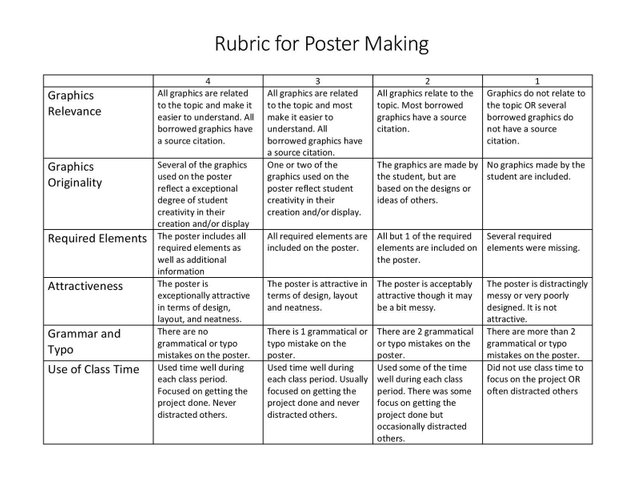EDUCATION SERIES #1: Importance of RUBRICS in Assessing Student Output and Performance (Real-Life Application Inside)
What is a Rubric?
A rubric is a tool used to assess student performance using level of descriptions and degree of completion based on the output produced or process performance.

PHOTO CREDIT: READINGBYEXAMPLE
A scoring guide for assessing student products and performances, a rubric works in a different ways in advancing student learning, improve teaching, clear assessment, and can be a source of information to develop an academic program.
Why is Rubric Important?
The main purpose of a rubric is to assess performance. In school, rubrics are used to assess student’s performance while doing something or to assess a finished product a student submitted for a certain course.
Rubrics make things clear for students as to how their work should be done and the level of quality they should put into their work. Clarifying these objectives is done by specifying learning targets and the criteria to a successful result. Rubrics help teachers teach relevant concepts, coordinate and validate instruction and assessment, and rubrics help students learn by targeting relevant issues relating to the activity at hand.
Types of Performances Rubric is Used to Assess With
According to Susan M. Brookhart, in her book How to Create and Use Rubrics for Formative Assessment and Grading, there are two types of performances rubrics can be used to assess with: processes and product.
Processes are performances that focus on how things are being done and how well they are executed to produce the expected outcome. Like the delivery of a speech, dancing or singing in a competition, playing a musical instrument, showing how to hit a tennis ball with a backhand stroke, or how to grow microgreens in a potted tray.
Products are more tangible and physical output of students as a result of an assignment or a project. Needless to say, examples are a reaction paper on the issue of voting, an innovation of a certain product, an artwork, software or hardware, a model of an airplane, or that beautiful music recorded as MP3.
A rubric, then, may be designed to assess both processes and products or the assessment may be done separately.
A Real Life Scenario
The following example was from my Computer Class.
Poster-Making Contest Details
Poster must depict the EIS ESLO through photos and texts.
Photos in the poster must be at least 80% original. This means you need to use your own device or camera to take the photos for your poster. You may also ask for original photos from other groups or clubs like the Photography club. The rest may be taken from other sources.
- The texts must be coming from EIS ESLO only.
- The poster may be in color or gray scale.
- Poster size must be A3 paper and printed.
- You may choose either a portrait or landscape layout.
- Use only Photoshop to design your poster.
Mechanics
- The poster will serve as 2nd Quarter Exam (25%) and Project (10%).
- All posters must be submitted on or before December 4, 2014 and are eligible to win THB 1,000.00 when chosen as best poster.
- Poster is given 30 points. A daily deduction of 3 points is given for late submission. This does not include weekends and holidays.
- Posters must be submitted in printed format and Photoshop document format. Please indicate your name, grade and section at the back of the poster. Filename: poster-YOURNAME.
- This poster-making contest is in cooperation with the PR and Marketing department. If you have further questions on the prize and details of the theme, please proceed to Room 312.
Here’s the rubric I have composed for this activity:
Benefits of Rubrics
Rubrics make the learning target more clear. When descriptions in the rubric are clearly stated, students will see what in details the learning target and has a better chance to hit it. Rather than producing an output based on guesswork, students have clearer view of what they’re supposed to do to get better assessment outcome.
Rubrics guide instructional design and delivery. When teachers have carefully articulated their expectations for student learning in the form of a rubric, they are better able to keep the key learning targets front and center as they choose instructional approaches and design learning environments that enable students to achieve these outcomes (Arter, J. & McTighe, J. Scoring Rubrics in the Classroom.)
Rubrics make the assessment process more accurate and fair. For teachers, there is no “guessing” or “estimating” how to assess a performance since the criteria are well-articulated in the rubric. Students will see fairness and honesty especially if the rubric is also used by their peers to assess their work.
Rubrics provide students with a tool for self-assessment and peer feedback. Having a rubric in hand, students are able to assess their own work, make modifications, and improvements in order to come to an excellent output. When students are involved in peer assessment and feedback, a rubric provides an honest tool and without bias for students to use.
Limitations and Challenges of Rubric Design
Rubrics, when well-designed, are a great tool for assessing student performance. However, rubrics are not the “holy-grail” of assessment and evaluation but they sure do wonders in the field of assessment of student performance.
Rubrics take time to design if the teacher is really honest and involved in assessing her students’ performance.
And, if a rubric is designed poorly, it may actually throw-off the students from the actual learning targets.
To make sure rubrics work as they should, they have to be validated, tested, implemented to ensure its efficacy and promote student learning.

